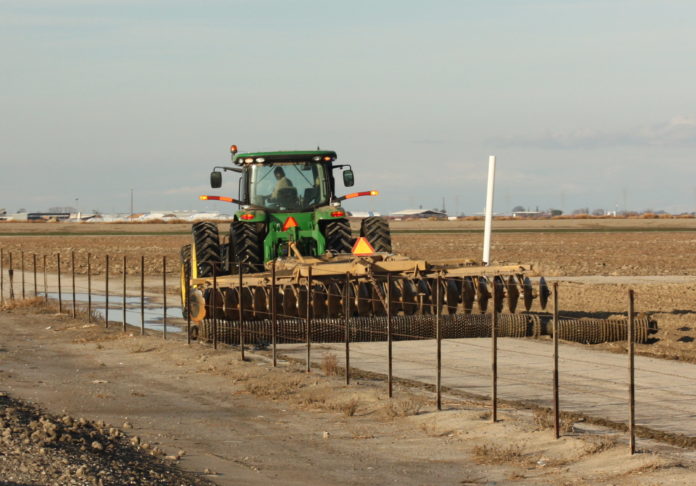 The Tulare Irrigation District held its board of directors meeting on Tuesday, December 14, 2021 at its rural Tulare headquarters and Zoom. Chairman David Bixler called the meeting to order at 9:00am and there was full board and man, I’m not kidding, you could really hear everything well. So, TID can hold an online meeting without it costing an arm and a leg while providing a clear view and clear, clean and ample audio. It can be done and the public gets the information it desires without spending almost $5 per gallon of gas and almost everyone is happy.
The Tulare Irrigation District held its board of directors meeting on Tuesday, December 14, 2021 at its rural Tulare headquarters and Zoom. Chairman David Bixler called the meeting to order at 9:00am and there was full board and man, I’m not kidding, you could really hear everything well. So, TID can hold an online meeting without it costing an arm and a leg while providing a clear view and clear, clean and ample audio. It can be done and the public gets the information it desires without spending almost $5 per gallon of gas and almost everyone is happy.
The Meeting/Friant
There were no public comments and General Manager Aaron Fukuda introduced Friant Water Authority Chief Executive Officer Jason Phillips. Phillips was invited to give an update on all things Friant. He said repairs to the Friant Kern Canal are shaping up well. The costs are just north of $290 million for the task before them. He said there has been a series of good news events rolling in. The financing is coming together. The Eastern Tule Groundwater Sustainability Agency is ground zero for the subsidence impacts on the canal. ETGSA agreed to pay for a portion of the costs and Phillips said the good folks there are working away at meeting the agreement. He said the $50 million FWA contribution had hit a snag with the City of Fresno threatening to sue but that was resolved and the city is making its payments. The state has coughed up $100 million and Phillips said Department of Water Resources’ Chief Karla Nemeth has kept things moving in a direction that will actually help and was thankful she sees the real world needs. FWA will get $39 million out of those funds for canal repairs. He said under Senate Bill 559 the needs of the various canals were divided by a percentage. Friant had 40 percent and that is reflected in this award of funds. Fukuda said all the funds the FWA team was able to cobble together was amazing.
Groundwater Sustainability Agency is ground zero for the subsidence impacts on the canal. ETGSA agreed to pay for a portion of the costs and Phillips said the good folks there are working away at meeting the agreement. He said the $50 million FWA contribution had hit a snag with the City of Fresno threatening to sue but that was resolved and the city is making its payments. The state has coughed up $100 million and Phillips said Department of Water Resources’ Chief Karla Nemeth has kept things moving in a direction that will actually help and was thankful she sees the real world needs. FWA will get $39 million out of those funds for canal repairs. He said under Senate Bill 559 the needs of the various canals were divided by a percentage. Friant had 40 percent and that is reflected in this award of funds. Fukuda said all the funds the FWA team was able to cobble together was amazing.
Phillips said DWR wants recognition for its contribution. Mention in literature and billboards. Everyone thought that reasonable. He said this is the first really big move by Governor Gavin Newsom to push for infrastructure improvements that many in the enviro/law firm/neo-pagan religious community didn’t approve of. Phillips didn’t use those words but I did. Phillips said the construction schedule has been laid out to benefit everyone the best. Dewatering will coincide with construction needs and there really shouldn’t be any lapse in operations during critical times.
Phillips said at the recent Friant board retreat there was a lot of talk about what comes after this middle reach capacity is fixed. He said staff asked the board for direction at the retreat. The options of special projects or everyone all in. He said to his surprise it was all in and staff will be bringing ideas to the board next month. He recognized there is repair funding fatigue but no one wants to have to turn away supplies during wet years due to lack of planning.
Fukuda said modeling which improvements need to be made on the system and how to prioritize them could be copied from the Temperance Flat modeling. He said he’d talked that over with Bill Swanson from Stantec.
Phillips said a priority from the retreat is protecting Friant supplies and how to reduce events where the Bureau makes calls to give water to the Exchange Contractors from Millerton Lake. He said the past 82 years show only two scenarios where such a call would be made. Even though 2020-21 were two back to back dry years, record setting actually, but a great amount of work with Ex Con and the Bureau allowed Friant to keep its supplies. In the past reservoir operations prevented calls but intensive regulatory impacts won’t allow drawing down Shasta to the levels of a very dry 1977.
events where the Bureau makes calls to give water to the Exchange Contractors from Millerton Lake. He said the past 82 years show only two scenarios where such a call would be made. Even though 2020-21 were two back to back dry years, record setting actually, but a great amount of work with Ex Con and the Bureau allowed Friant to keep its supplies. In the past reservoir operations prevented calls but intensive regulatory impacts won’t allow drawing down Shasta to the levels of a very dry 1977.
Phillips said as of December 1st there was only a 15 percent probability of a call on Friant. He said with this current storm and it is raining and snowing as this meeting is taking place, the probability should decrease by next month. However, this is California and water and if we don’t get more storms this winter and spring all bets are off.
Next Phillips said Lake Millerton is so small – half a million acre feet – flows that would make the larger reservoirs whole will put Millerton into flood control and he wants Friant to get the Bureau to agree to let Friant make the call for carryover and such. He said the Biden presidential order suspending the 2019 biological opinions is a bummer. A court case was building with the State and enviro NGOs suing over the biops and it didn’t look like they would win, the biops’ science is sound. So, Biden got nervous and pulled that trigger. Phillips said at the career leadership level the feds want to keep any changes as small as possible. There is a new biops review scheduled for 2024. At present the feds will have to provide interim regulation under the presidential order until 2024. Phillips said there are portions of the government who are working from fear. They’re afraid they have a system in place they no longer know how to operate. They are scared of climate change.
possible. There is a new biops review scheduled for 2024. At present the feds will have to provide interim regulation under the presidential order until 2024. Phillips said there are portions of the government who are working from fear. They’re afraid they have a system in place they no longer know how to operate. They are scared of climate change.
At the retreat, said Phillips, they worked Director Rick Borges to a frazzle. He said the San Joaquin Valley Water Blueprint is still a high priority as is the San Joaquin Valley Collaborative Action Plan. He said the Blueprint and CAP are working well together so far. He said a better governance for the Blueprint is needed to provide a voice and a place at the table. He said it won’t go far if it appears to be all Friant all the time. There is now a 23-member board at the Blueprint and he named a bunch of names that often appear in these reports. And as an example – elected representatives are asking the Blueprint for suggestions on how to spend the billions of taxpayer dollars in the infrastructure bill.
The cost of water was the next topic. Phillips uttered a sacrilege, a blasphemy to journalist – if the member districts stopped providing food at the meetings there would be enough savings to fund . . . he stopped before he went any further. He said the real costs can be reduced if everyone puts focus and effort into solving the increased costs. Power, aging infrastructure and other obstacles are popping up. For instance San Luis Delta Mendota has some repair needs for the Delta Mendota Canal and it looks like they’d be happy to charge Friant a big chunk of change if Friant isn’t paying attention. Borges said the new CFO Wilson Orvis has a great amount of energy and everyone is really pleased with his addition. Fukuda said playing golf with him is insane. He said Orvis isn’t an accountant – he has a biology degree and is smarter than any three or four guys you could grab and duct tape together.
Director Dave Martin said he’d read something recently stating some of the releases into the Sacramento River are used to cool the river after municipal treated water is discharged and heats up the water if I understood. Phillips said the State Board has used some sideways dance steps to get in the saddle in regulating for wildlife. The State Board has abandoned the Voluntary Agreements with the SJR tributaries. Everything downstream of the SJR is being regulated under Phase One. The Sacramento River senior rights holders are in the cross hairs for the State Board’s power grab. He hopes the senior rights holders would support Friant and Friant and the CVP can support them. Good for him to say that. Often it looks like folks from the San Joaquin Valley and Sacramento Valley fire rockets at each other. The real target is in between, Sacramento. As Fukuda said as soon as something appears to be resolved, like the biops, you wake up and a new problem is introduced.
sideways dance steps to get in the saddle in regulating for wildlife. The State Board has abandoned the Voluntary Agreements with the SJR tributaries. Everything downstream of the SJR is being regulated under Phase One. The Sacramento River senior rights holders are in the cross hairs for the State Board’s power grab. He hopes the senior rights holders would support Friant and Friant and the CVP can support them. Good for him to say that. Often it looks like folks from the San Joaquin Valley and Sacramento Valley fire rockets at each other. The real target is in between, Sacramento. As Fukuda said as soon as something appears to be resolved, like the biops, you wake up and a new problem is introduced.
Director Michael Thomas said each year in January to celebrate his wife’s birthday they go to Deer Creek to watch the cranes. He wonders how much more subsidence could be lurking around the Valley. Phillips said ETGSA and Friant have an agreement, as does Pixley ID that understands there will be more subsidence and that will be addressed in the plans for the repairs. He said the new canal will be built with an extra five feet of freeboard. However, the limit is three feet. Anymore and curtailments kick in against landowners if that three feet is exceeded. There is a subsidence team and a plan for monitoring and such. That was about all Phillips had to say and he left.
Fukuda said he meant to announce there is a new intern present. Anthony Sauza is a junior at Fresno State and is from Tulare. He’s a construction manager major and loving the job at TID. There is also another intern and the Land IQ assessments are coming up and staff is happy for the help. Someone asked how long they will be at TID and Fukuda said as long as they can. He’d like to keep them on during the summer.
Water Report
Water Master Marco Crenshaw reported Lake Kaweah is at 20,000 a/f and releases are all in basin. Millerton is at 373,000 a/f. The snow reports show an increase of the Kaweah snowpack to be 80 percent of normal and the San Joaquin River watershed is similar.
Crenshaw likes to follow the “Blob”, a warm water mass floating around the Pacific Ocean that has an impact on precipitation in California. But the blob has been behaving like a blob and not substantive as of late. I asked on the Zoom chat feature if Crenshaw has been made aware of the Pig Spleen forecast and got no response.
Fukuda gave the board an update on TID groundwater levels. It’s a colorful map full of geographic specifics unique to TID and a bunch of arrows showing underground drift and flows. One option is a groundwater mound south of the City of Tulare could be used as a source of water if it is pumped into a canal and sent west. There is a hole, a low water level area just west. Water quality is a question here as the water mound is created by Tulare discharge and Tulare is treating for nitrates. Martin said when he was a teenager, must have been the 1980s or so this pumping was into a canal was proposed. Fukuda recommended a cost-benefit analysis be conducted on this idea.
Fukuda said groundwater levels are low enough now should there not be a good water season there will be a similar circumstance as in 2015, a very dry year. He said TID has been around long enough to know something new has to be done and it has to be done now or the costs will run off and eventually become prohibitive.
Fukuda showed a graph of the shallow aquifer and the confined aquifer under the clay layer. For the most part water levels between the two don’t fluctuate the same. He also said an elementary school in the district has donated a well for monitoring. This will save the costs of monitoring. Good for them. Fukuda also said district engineer Jeremy Barroll has been diligently reading the groundwater measurements rain or shine. He hopes a grant will come in to allow more remote monitoring. And he said he hopes to have five or six more monitoring wells coming online in the next year or two. He also said in his experience as an engineer, there really is nothing better for measuring a well than a metal tape. Although they tend to fall down the well now and then.
If there is any flood release coming up Fukuda and the board agreed whether it goes to recharge or what, no one wants to lose any carryover at Millerton.
O&M Report
The Operations & Maintenance report was given by Superintendent Wayne Fox who said most of the efforts have been to cleanup as much as the crews could. The work ranged from canal banks to homeless camps.
Financial Reports
Controller Kathi Artis gave her report and it was as good as ever. The board approved and thanks to Artis and other staff the district had enough money in the bank to pay its bills. The board agreed to hire Cuttone & Maestro for the audit.
At this point the meeting had wandered into the start of its third hour and showed no signs of slowing down or wrapping up. Some districts are like that. Others not so much. Both Buena Vista Water Storage District and Kern Water Bank have had full meetings less than a half hour long. I once sat through a nine-hour Madera ID meeting, most of which was spent in the break room awaiting a closed session decision. So, if you go to a Tulare ID meeting don’t get in a hurry and be thankful for the unity of the board and staff and also be thankful you don’t have to sit in closed sessions.
Engineering Report
District Engineer Barroll reported there was some electrical crossing and other utilities going over or under, I wasn’t sure of a TID canal. He said he been helping Fukuda.
SGMA
Fukuda gave the board an update on the Kaweah Subbasin and the three GSAs: Mid Kaweah, Greater Kaweah and East Kaweah. Pumping caps are; MKGSA 2.5 a/f, GKGSA 2.5-3 a/f and EKGSA 1.65 a/f. The penalty for over pumping MKGSA $500 plus future loss, GKGA $500 plus future loss and EGKGSA $500. These penalties are all per a/f. Fukuda said the three managers are talking daily and there are concerns about the pumping in White Areas. He’s concerned if there isn’t a miracle this winter the pumping is going to devastate many of the well due to dropping groundwater levels.
In addition to groundwater level concerns each critically overdrafted subbasin will get $7.6 million. Sequoia Riverlands Trust may soon be a partner in securing grant funds for the subbasin. They have the experience for many of the goals envisioned.
Fukuda is the GM of MKGSA as well as TID. He said Mid Kaweah has received a letter sent from the State Board to DWR about GSPs. He didn’t respond since he also received a letter from DWR specifically about the MKGSA GSP that he’s working on addressing. One of the problems had to do with water quality. The state wants more info but that is often in private-landowner hands. DWR wants more information about water rights associated with proposed mitigation projects. There is a concern more than one GSA is planning on using the same water supply.
Martin represents TID on the MKGSA board and he said mitigation has to come with responsibility. Private wells are the responsibility of the landowner. Fukuda said each month he and his wife put money aside, money they would have been paying to a utility if they lived in town, to prepare for wells and septic tanks and such needs. They chose to live in the country and they are willing to take the trouble to protect themselves. I don’t think any of the GSAs want to take responsibility for someone who is not keeping their well in shape. Or, as often happens, the party purchasing land failed to check out their water situation in the first place.
the country and they are willing to take the trouble to protect themselves. I don’t think any of the GSAs want to take responsibility for someone who is not keeping their well in shape. Or, as often happens, the party purchasing land failed to check out their water situation in the first place.
Fukuda said he wasn’t too worked up over the State Board letter as it had to do with cooperation within the subbasins. The DWR letter is another matter. The DWR evaluation goals were listed in the letter and once the evaluations are received from DWR there will be 180 days to submit how a GSP will be altered to comply with the issues that need to be addressed. However, DWR has been pretty upfront about the problems it has found in other GSPs and if your eyes are open you can see what will need to be most likely addressed.
Engineer James Fisher reported on what’s happening with Land IQ satellite Evapotranspiration data and conveying that to growers. Fisher said the interns are really helping out with this large amount of data. He said the preliminary results have been complied and he posted a graph showing the amount of ET by month. He’s preparing a newsletter to show the ET per month by crop type.
More Reports
Next Fukuda gave an update on the McKay Point project. TID has retained Capital Corp as a bird dog for grant funding. CC found the opportunity to work with FEMA and Cal Office of Emergency Services for $15 million which will fund the project. Of course it’s most likely a matching grant so TID isn’t in the clear but CC thinks it can get a long term, low interest loan for the balance.
Under legislation there is a trash can full of taxpayer funded money getting turned lose from Washington. Fukuda said he doesn’t have the bandwidth to shepherd the opportunities so he asked to keep Capital Corp on board to help.
GM Report
Fukuda said he’s getting calls from landowners wanting to know what’s going on. Their wells are failing and more and more folks are ready to work together to address the issues they all share. There has been some confusion regarding satellite ET for cover crops and that has to be address with more ground truthing if I understood. He said Fisher and the interns are really getting up to speed in turning around the Land IQ data and getting it to growers asap. Martin said his alfalfa isn’t taking much if any ET today and while he is willing to do his part he isn’t willing to pay for ET that isn’t happening.
wells are failing and more and more folks are ready to work together to address the issues they all share. There has been some confusion regarding satellite ET for cover crops and that has to be address with more ground truthing if I understood. He said Fisher and the interns are really getting up to speed in turning around the Land IQ data and getting it to growers asap. Martin said his alfalfa isn’t taking much if any ET today and while he is willing to do his part he isn’t willing to pay for ET that isn’t happening.
Fukuda said the situation right now is not conducive to water marketing. There has to be better water conditions before a sustainable market can be established. Also dairies are complicated. Fukuda said Innovative Ag Services wants to talk to the GSA about how better dairy water management can be implemented under SGMA. IAS is a good outfit and it would be wise in my opinion to give them the EF Hutton treatment – when they speak – listen.
Fukuda got a lot of questions at a recent Grower meeting about the neighbors. TID has had a recharge plan for decades. Martin said 60-years ago most of the land being farmed was near surface water. He said he remembers most of the white area when he was a kid was dry pasture or range. Fukuda said he was told by a grower if the white area continues to impact TID land he would be concerned about his land being valued like the much cheaper land in the white area.
Well folks, at this point the meeting had exceeded more than three and three/fourths hours with still no sign of letting up and there are other meetings to attend and my butt is getting tired of sitting. I expect TID retains Cuttone & Mastro for its auditor and renews its membership to the California Farm Water Coalition. Then the directors will give their reports and then closed session for six items or so ranging from personnel to lawsuits. Be good to each other and yourself.
DISCLAIMER OF RESPONSIBILITY; Waterwrights strives to provide clients with the most complete, up-to-date, and accurate information available. Nevertheless, Waterwrights does not serve as a guarantor of the accuracy or completeness of the information provided, and specifically disclaims any and all responsibility for information that is not accurate, up-to-date, or complete. Waterwrights’ clients therefore rely on the accuracy, completeness and timeliness of information from Waterwrights entirely at their own risk. The opinions expressed in this report are those of the author and do not represent any advertisers or third parties.
ALL RIGHTS RESERVED. Copyright 2021 by WaterWrights.net/DAW
TULARE IRRIGATION DISTRICT
6826 Ave 240, Tulare, CA 93274 Office: 559/686-3425
Board: David G. Bixler- President, Richard S. Borges, Jr.-Vice President, Scott Rogers, Dave Martin & Michael Thomas
Staff: Aaron Fukuda-General Manager, Jeremy Barroll-Engineer, Kathi Artis–District Controller, Wayne Fox–Superintendent, Marco Crenshaw–District Watermaster & Alex Peltzer-Attorney.
About: The Tulare Irrigation District was organized September 21, 1889. The original proposal for the formation of an irrigation district covering 219,000 acres, extending from the Sierra Nevada foothills to Tulare Lake, was eventually reduced to 32,500 acres. The District continued in this status until January of 1948 when the so-called Kaweah Lands” (approximately 11,000 acres) were annexed. In October of 1948, approximately 31,000 acres, compromising the area served by the Packwood Canal Company were annexed to the District. A U.S. Bureau of Reclamation contract was signed in 1950 providing an annual supply of 30,000 acre-feet of Class 1 water, and up to 141,000 acre-feet of Class 2 water from the Friant-Kern Canal. The District and the Kaweah Delta Water Conservation District have coordinated efforts to enhance the recharge of groundwater within the Kaweah Basin. During high flow times KDWCD may use the recharge basins with the District for recharge purposes. Further, KDWCD has historically provided for a financial incentive program through which the District sustains the level of groundwater recharge from supply sources into the District. This historical program was recently reinstated by both districts in lieu of the District’s plans to concrete-line this canal to conserve the surface water. TID is a member of the Mid Kaweah GSA DWR#-5-022.11
































